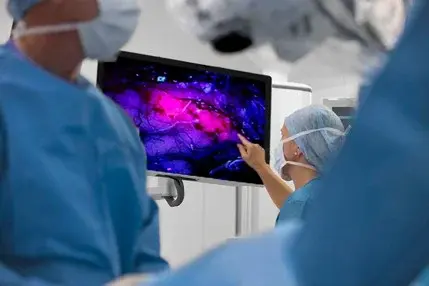Important Safety Information
Contraindications
Do not use Gleolan in patients with:
- hypersensitivity to aminolevulinic acid (ALA) or porphyrins
- acute or chronic types of porphyria
Warnings and Precautions
Due to the risk of phototoxic reactions, do not administer phototoxic drugs and topical preparations containing ALA for 24 hours during the perioperative period. Reduce exposure to sunlight or room lights for 48 hours after administration of Gleolan.
Errors may occur with the use of Gleolan for intraoperative visualization of malignant glioma, including false negatives and false positives. Non-fluorescing tissue in the surgical field does not rule out the presence of tumor in patients with glioma. Fluorescence may be seen in areas of inflammation or metastases from other tumor types.
Hypersensitivity reactions, including serious hypersensitivity reactions have occurred; these reactions include anaphylactic shock, swelling, and urticaria. Always have cardiopulmonary resuscitation personnel and equipment readily available and monitor all patients for hypersensitivity reactions.
Adverse Reactions
Adverse reactions occurring in >1% of patients in the week following surgery were pyrexia, hypotension, nausea, and vomiting.
Nervous system disorders occurred in 29% of patients within the first week after surgery and events occurring in >1% of patients included: aphasia (8%), hemiparesis (7.8%), hemianopsia (3.2%), headache (2.7%), seizure (1.9%), hemiplegia (1.9%), monoparesis (1.3%) and hypoesthesia (1.1%). Brain edema occurred in <1% of patients in the first 6 weeks after surgery. In a randomized clinical trial, the numbers of serious neurologic adverse events in the post operative period were higher in patients randomized to ALA fluorescence arm compared to the control arm. An imbalance was notable for the adverse events aphasia, ataxia, convulsion and hemianopsia and is likely related to the higher amount of brain resection performed in the ALA arm. At longer follow up periods, the numbers between the two arms appeared similar.
Worsening of >2 Common Toxicity Criteria grades in alanine aminotransferase and gamma-glutamyl transferase occurred in 15.8% and 11.6% of patients, respectively, within the first week after surgery. Absolute levels ranged from 2 times to greater than 10 times the upper limit of normal for each parameter. At 6 weeks, these measurements remained elevated in 2.9% and 7.5% of patients, respectively. There were no cases of liver failure.
Drug-Drug Interactions
See information under Warnings and Precautions regarding phototoxic reactions.
Please see Full Prescribing Information
For medical inquires, please fill out our Medical Information Request Form.




